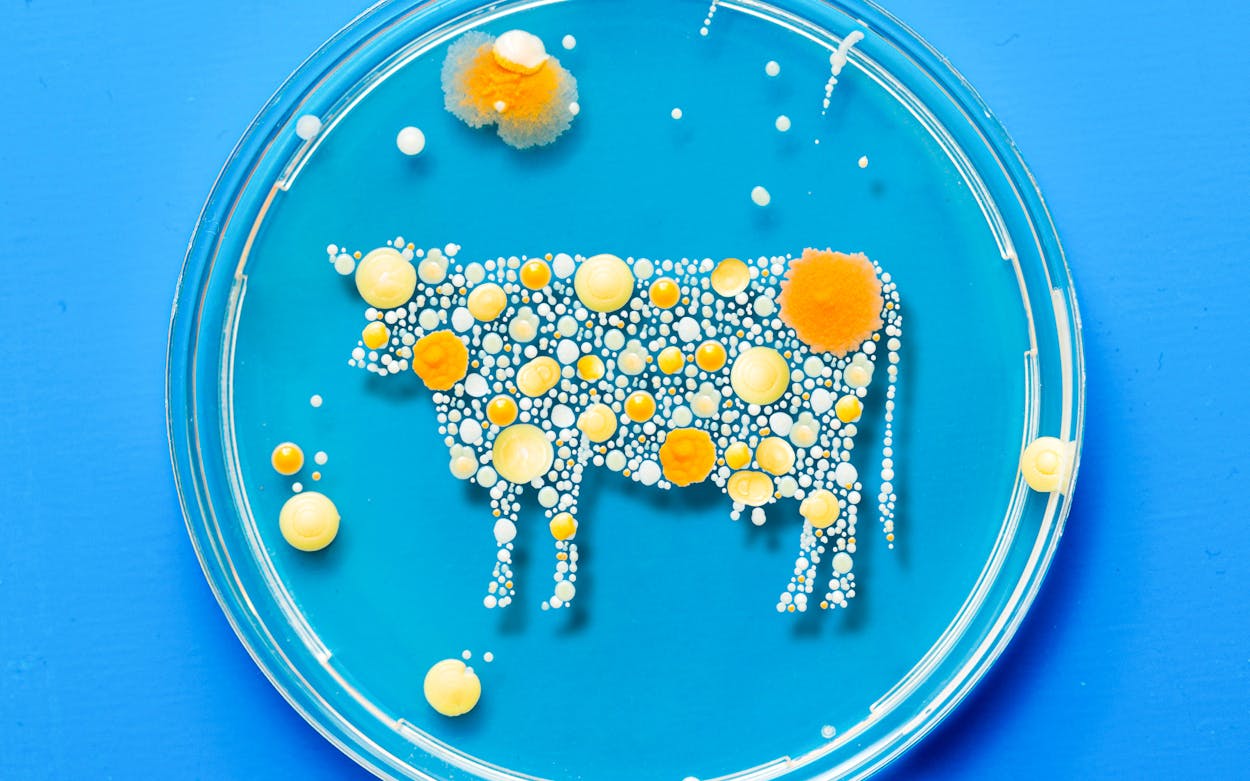You can take the cow out of Texas, but you can’t take the Texas out of the cow. Since Spanish settlers first introduced bovines to the region we now call Texas back in the seventeenth century, cattle have been the state’s most vital agricultural commodity. And they’re so much more—an archetype as embedded in the vocational identity of the state as roughnecking is. The longhorn is the state animal and the team mascot, its logo as recognizable as a couple of fingers thrown into the “Hook ’em, Horns” sign. Of course, there would be no such thing as a Texas cowboy if not for the cows. Today, the Texas cattle industry is the country’s largest, representing 14 percent of the nationwide inventory of cattle and calves. “It’s truly a way of life and the lifeblood of so many of our rural economies and our communities,” said Ben Weinheimer, the president and CEO of the Texas Cattle Feeders Association. “Cattle are woven into the fabric of the state.”
But meat and meat production are changing. In 2013, Dutch scientist Mark Post proved to the world that meat could be grown from stem cells extracted from a live animal, in a lab. He ate his proof of concept, a cell-cultivated hamburger that cost more than $300,000 to develop, at a London press conference; since then, more than 150 startups across the globe have launched their own attempts at producing cultivated meat. Last year, the U.S. Food and Drug Administration cleared cell-cultured chicken grown by the California-based Upside Foods as safe for human consumption, a breakthrough that brought cell-cultured meat one step closer to landing in our grocery stores. Companies are even rethinking Texas barbecue: Austin-based BioBQ promises to produce the same brisket we know and love, minus all the blood and guts and slaughter.
Not surprisingly, folks in the cattle and feedlot industries are abuzz. “The vast majority of farmers and ranchers are aware that cell-cultured products are being developed,” said Tracy Tomascik, associate director of the Commodity and Regulatory Activities division at the Texas Farm Bureau. The emergent technology surfaced as the main topic of discussion at one of the bureau’s recent summer meetings, he said. Tomascik said that cattle folks were shocked by the amount of money being invested in the research and development of those products. In total, cultivated meat and seafood companies across the globe have raised some $2.8 billion in investments. Of course, that number pales in comparison to how much the U.S. government spends on subsidies for farmers per year, and Texas is the biggest beneficiary. The state received more in farm subsidies from 1995 to 2021 than any other state, including $2.2 billion in that final year.
The emergence of cultivated meat inspired legislation in both House and Senate, one authored by Republican state representative Brad Buckley, of Killeen, and the other filed by Republican senator Charles Perry, of Lubbock. The bills, which supporters have been calling the “truth in labeling” legislation, would require cell-cultured and “analogue” products (that is, a food product derived from plants or other ingredients to approximate the texture and taste of meat, dairy, or eggs—like the Impossible Burger) to be clearly demarcated as such in a “prominent type of uniform size” in their food labels. The issue comes down to an argument of semantics. Most alternative meat and dairy companies already have indicators to communicate the material contents of their products, though they might use designations such as “100 percent vegan” instead.
“Consumers need to know when they’re purchasing fake meat,” Buckley said as he introduced his current bill before the House’s Committee on Public Health on April 3. He drew a comparison between cell-cultured meat and cubic zirconias: “Looks like a diamond to the naked eye, but it’s not a diamond.”
Both Buckley and Perry filed similar bills last session, though neither bill made it through both chambers of the Legislature—casualties of a tight calendar. This year, Perry, whose bill was voted out of committee earlier this week, said he has reason to believe the legislation will become law. And Representative Four Price, of Amarillo, who sits on the House Committee on Public Health, signaled his strident support of Buckley’s bill during its committee hearing earlier this month. The bills are fully backed by the industry: Joy Davis, the Texas Farm Bureau’s associate legislative director, testified in support of Buckley’s bill. “Scientists have 3-D printed a steak,” she said in the hearing. “Who knows what tomorrow will bring.”
Proponents of cell-cultured meat argue that there are lots of reasons to reconsider the traditional means of meat production. From flatulence and belching alone, livestock are responsible for 14.5 percent of greenhouse gas emissions worldwide at a time when our planet can’t stand to get much hotter. And while the cattle industry might evoke pastoral visions of cows and cowboys on the range, in reality, concentrated animal feeding operations (CAFOs), better known as feedlots, drive the means of meat and dairy production in the country. (In Texas, ranches still make up the majority of cattle operations.) Congested and shrouded in clouds of fecal dust, CAFOs generate a high concentration of animal waste within small areas of land. This not only produces a powerful smell, noticeable from miles away, but also has the potential to threaten drinking water because of harmful levels of substances like nitrogen and phosphorus, which can lead to health issues, especially in infants.
Katie Kam, cofounder and CEO of BioBQ, said that when she was a graduate student at the University of Iowa, where she became pregnant with her first child, she was afraid to drink the water because of possible contamination from nearby agricultural operations. She launched her company, which she runs with University of Texas professor and bioengineer Janet Zoldan, in 2018. “I saw cultured meat as this win-win solution,” said Kam, who became a vegetarian in 1998 out of concern for animal welfare, and then turned fully vegan in 2008. “People get to have the meat that they want without the unnecessary slaughter and suffering and environmental impact. It just seems like such an obvious solution.”
Kam grew up in Dallas and Austin and worked at a barbecue joint in high school. She acknowledges how embedded cattle country is in the Texas ethos. “I absolutely love the challenge. That’s part of the reason I chose brisket,” she said. “I think it’s just such a Texas thing to go after for cultured meats.” Part of the challenge is nailing the texture of the cut of meat, which is made up of what she called “muscle bundles,” interspersed with fat. Kam hasn’t yet sampled her own product, instead letting others on her team take the lead on taste-testing, since she said she doesn’t fully trust her ability to know what meat should taste like after so many meatless years—but she assured me that she eventually would. Kam said she’s worked with a local cattle rancher to extract the muscle and fat cells, which are then fed nutrients to grow inside a bioreactor. A scaffold provides the shape into which the tissue grows; in theory, you could cultivate a piece of meat to form into the shape of Texas. “Some people do mention, ‘Ew, ick, you’re growing something in a lab,’ ” she said. “I’m like, ‘Have you been inside a slaughterhouse?’ ”
Kam said she has every intention of labeling her product differently, with or without a new Texas law: “If we wanna get down to labeling of meats, I think they should call their meats slaughtered meats so people know that their meat’s coming from slaughtered animals.” Kam added that she didn’t see the point in getting states involved, when the decision should be left up to federal agencies, such as the FDA and USDA, to set labeling guidelines. Robert Rankin, the executive director of the Association for Meat, Poultry and Seafood Innovation, whose members include companies that produce both analogue and cell-cultured products, said that the association and its members support full transparency in labeling, but echoed Kam’s concerns. “Because the FDA and USDA have not yet developed federal labeling requirements for these products, we are concerned about the potential to create consumer confusion through differing federal and state labeling requirements,” Rankin said.
Proponents of the labeling bills say they’re not trying to stifle alternative protein companies, only to encourage transparency. “Although I do not have a problem or issue with these new alternative choices, it is imperative to protect the consumer and not allow them to be misled by a product’s packaging,” Senator Perry told Texas Monthly. The bills mirror similar efforts from the dairy industry to challenge plant-based alternatives—which have contributed to declining sales in cow’s milk—from using the word “milk” in their labeling. Earlier this year, the FDA issued new draft guidance saying that plant-based beverages could be sold as “milk.” The agency made the decision based in part on focus groups that showed the average consumer was not a dodo and could, in fact, discern plant from cow. However, the agency recommended that alternative milk companies indicate the source ingredient in their labels—such as soy milk, or oat milk. “The meat industry doesn’t want to walk into a situation, twenty years from now, like the dairy industry is dealing with, having to fight and debate over what milk is,” said Tomascik.
But that situation still seems a remote possibility. BioBQ has a long way to go before becoming the supplier for local pitmasters, including a formal seed fundraising round this summer. Until now, Kam’s company has relied on research-grant funding, a gift donation, and bootstrapping. Meanwhile, Impossible Foods and Beyond Meat, the two biggest companies that peddle products that look and taste like meat but aren’t, have experienced a precipitous decline in sales after an initial surge in 2020. But America’s taste for beef abides.
Weinheimer said that his preferred piece of meat is a medium-rare ribeye. “You get it at the right internal temperature, you get the right sear on that ribeye, and it’s literally the melt-in-your-mouth version of a high-quality eating experience,” he said. Would he ever try cell-cultured meat? “I’ve never been presented the opportunity,” he said. “I’ll need to cross that bridge perhaps when the day comes.”
- More About:
- Politics & Policy
- Texas Legislature
- Cattle








